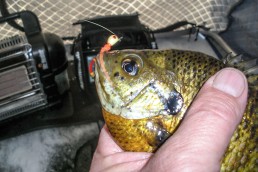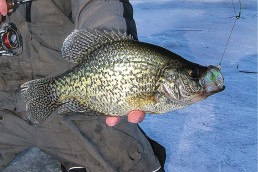The Impact of Plastics on Ice Fishing
SHARE THIS POST
In the last five years, there has been a big change in ice fishing. If you are thinking battery powered augers, that is a good choice. However, what I am thinking about is the impact that plastic has had on the way we fish and the baits we are fishing with during the ice-fishing season. How much have plastics changed your ice fishing?
Live bait dominated ice fishing in the past. You used either minnows, waxies or euros to tip your ice jigs in-line with what you were fishing for. And, may I add, with great success! Then, plastics started to appear as an option and started to take over. You could say that the first introduction of plastics came from Custom Jig and Spin’s Ratso and Rat Finkie, both of these baits caught fish when called upon, but there was a bigger picture that was starting to take form.
Being a pro staff member of Lindy a few years back, they were the first ones to come out with a full line of ice plastics to put on your baits. They were scented, to boot. As far back I can remember, this was the first true introduction of an assortment of plastics shapes that you could use to tip your ice jigs with. This is just one part of what tilted the scale towards the beginning of plastics domination in ice fishing.
The phase out of live bait
Now, do not get me wrong, there is still a place for live bait in your ice fishing. I still have days that live bait is the choice of fish to get bites. Yet, I am finding out that these days are starting to become fewer and farther between.
In the past, I would say that live bait was the most popular choice to make. I started to use plastics. Live bait was catching the majority of my fish, but I was taking my biggest fish on plastic-tipped baits. I was using live bait as my main presentation, but, when the bite would slow down, I would put that rod down and grab a rod that had a plastic option rigged onto my ice jig. Then, I’d go to work trying to trigger a few more bites.
I could not get constant bites on my plastics, but I could depend on it to trigger a few random bites from time to time. So, that was really how I fished the bite. If I caught a few fish in a row and the plastics bite seemed to slow down, I would grab my rod rigged with live bait and get back to work.
There were many times that I tried to make the plastics be my lead bait, but, at that time, I would truly say I could not accomplish that. This was what triggered me to look at how was I going to make plastics a primary choice for ice fishing.
Plastics offer more to trigger bites. They come in every color, giving more visibility in all water conditions. That is key. If the fish can’t find the bait, they can’t bite it. Plastics even come in glow colors, something that live bait can’t do.
Swiftly turning from sweet to stinking
Another factor is live bait during the first 5 minutes has a positive scent. After that, the bait’s scent starts to turn negative. This could be the fact that the bait is starting to die. Added to that is the fact that the cold-water temps do not help. If you are not changing your live bait every 5 minutes, you are fishing with a bait that is putting off a negative scent instead of a positive one.
Are you enjoying this post?
You can be among the first to get the latest info on where to go, what to use and how to use it!
With plastics, you never have that happen. If you are using plastics that are scented, you will always have a positive scent working for you. One key that has to be called out here is you have to take a close look at what you are using to fish your plastics. Equipment is key.
Line size is critical
If you are using a line size that is too big, you are taking away some of the bait’s natural actions and also slowing down the fall of the bait.
To exaggerate the action of your plastics, fish it on a tungsten jig option. The faster-falling jig will intensify the action of your plastics. Keep this in mind and use it to your benefit. When the bite is cranking, grab a tungsten jig that is tipped with plastics and get to catching. If the bite is little off, I will many times choose to use a lead ice jig that is tipped with plastics. The plastics will not have as much action. It will be toned down a little, giving the fish a different look.
Now, if the bite is tough this will work in your favor. With some of the micro baits that are on the market now, the slight movements that will be transmitted through the line will be enough action to get you bites.
Rod action and line size will also play a part. If the bite is super tough, I will switch to a fiberglass rod. This will mute the action of the bait and my plastics. Most of the time, I will fish this on a reel that is spooled with 1-pound or 2-pound-test line.
If the bite is on, I will fish a graphite rod that is teamed with a reel that is spooled with either 2 or 3-pound line. This is the setup I use if I want to transmit more action to the bait and my plastics.
As you can see, there is a little work that will go into getting the perfect plastics setup. It will be well worth it. Don’t delay in starting. Plastics will help put more fish on the ice this season.
MWO
SHARE THIS POST
Did you enjoy this post?
You can be among the first to get the latest info on where to go, what to use and how to use it!
Scott Petersen
Scott Petersen has been writing for the past 30 years. A Minnesota native, he has a passion to fish all seasons on ice and open water. “One of my main goals is to teach people how to fish through my articles and sport-show seminars.”



